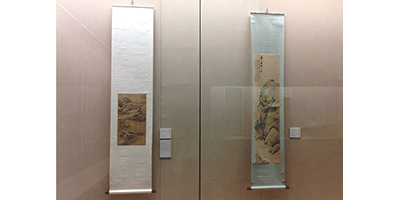January 29, 2014 report
Closer look reveals mechanism behind curling of ancient scrolls

(Phys.org) —A team of researchers in China has uncovered the reason for long side curling of scrolled artwork. In their paper published in Physical Review Letters, the researchers describe how experiments they conducted with various materials showed that curling results from stretching of backing material.
People whose job it is to protect ancient art face a variety of destructive elements, from moisture and chemicals in the air to microbes that eat away at fabrics and paints. With scrolls, there is another problem—curling that results when fabric or paper is rolled up for storage. In addition to being unsightly, curling tends to damage the art that is being stored. For that reason, conservationists have been searching for thousands of years for ways to prevent it from happening. In this new effort, the researchers appear to have made progress in that direction by revealing what happens when material is rolled up and why it curls as a result.
To find out what really happens when flat material is rolled up, the researchers subjected a variety of materials (plastics and paper) to rolling, watching very closely to see what changes came about. They also created computer models meant to replicate what occurred as rolling was applied. The one element they found that was common to all the test subjects was that the backing material underwent more stress than other parts and as a result was pulled slightly apart. When the material was unrolled (for viewing, for example) the material "tried" to shrink back to its original shape causing an expansion along its width—the end result being the familiar and undesired curling.
The findings by the team suggests that a way to reduce curling is to add a backing to the underside of scrolls with material that has fibers that align with the long edges. Another approach would be to create tiny perforations in the backing to reduce stress and thus stretching—a technique that has been used on Japanese artwork for generations—they use a stiff brush.
Interestingly, the work by the team in China may have a modern application—reducing curling on flexible electronic displays—a problem that consumers have recently been noting in newly developed bendable phone screens.
More information: Curling Edges: A Problem that Has Plagued Scrolls for Millennia, Phys. Rev. Lett. 112, 034302 (2014) prl.aps.org/abstract/PRL/v112/i3/e034302
Abstract
Qi-Wa refers to the up curl on the lengths of hand scrolls and hanging scrolls, which has troubled Chinese artisans and emperors for as long as the art of painting and calligraphy has existed. This warp is unwelcome not only for aesthetic reasons, but its potential damage to the fiber and ink. Although it is generally treated as a part of the cockling and curling due to moisture, consistency of paste, and defects from the mounting procedures, we demonstrate that the spontaneous extrinsic curvature incurred from the storage is in fact more essential to understanding and curing Qi-Wa. In contrast to the former factors whose effects are less predictable, the plastic deformation and strain distribution on a membrane are a well-defined mechanical problem. We study this phenomenon by experiments, theoretical models, and molecular dynamics simulation, and obtain consistent scaling relations for the Qi-Wa height. This knowledge enables us to propose modifications on the traditional mounting techniques that are tested on real mounted paper to be effective at mitigating Qi-Wa. By experimenting on polymer-based films, we demonstrate the possible relevance of our study to the modern development of flexible electronic paper.
Journal information: Physical Review Letters
© 2014 Phys.org



















